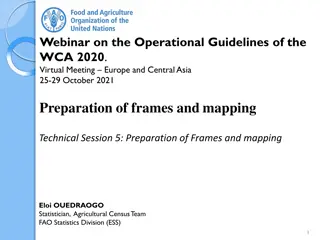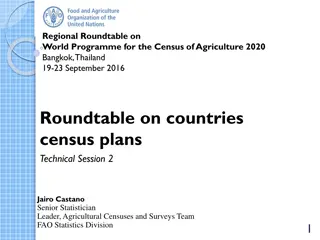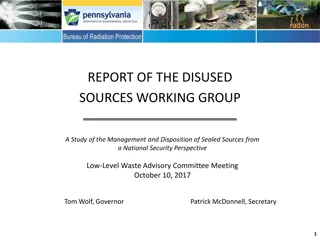Overview of Agricultural Finance: Importance, Classification, and Sources
Agricultural finance is crucial for the development of agriculture, providing farmers with the necessary resources for various purposes such as purchasing inputs, managing risks, and improving land. It is classified into short-term, medium-term, and long-term credit based on loan periods, catering to different agricultural needs. Sources of agricultural finance include institutional and non-institutional sources like moneylenders, supporting farmers in enhancing productivity and sustainability.
Download Presentation

Please find below an Image/Link to download the presentation.
The content on the website is provided AS IS for your information and personal use only. It may not be sold, licensed, or shared on other websites without obtaining consent from the author. Download presentation by click this link. If you encounter any issues during the download, it is possible that the publisher has removed the file from their server.
E N D
Presentation Transcript
Agricultural Finance Finance is an important input of agriculture which the farmers need for agricultural purposes Sufficient and timely credit to the farmers is vital and indispensable for the rehabilitation and progress of agriculture.
Need for finance 1. Purchase of new inputs 2. Purchase of implements 3. Better management of risk 4. Permanent improvement in land 5. Better marketing of crops 6. Facing crises
Classification of Agricultural Finance Agricultural credit has been classified into three categories based on the periods for which the loan is given. Theses are 1. short-term credit (crop loan) - for 15 months period and is meant for meeting the needs like seed, fertilizer, labour, cattle feed, etc. The farmer can repay the loan after harvest of the crop.
2. Medium-term credit. The period for medium term loan is from 15 months to five years. These loans are provided for meeting the expenses improvements, digging purchase of implements and machinery, farm animals, etc. repayment is kept upto 5 years. on of land wells, The period for
3.The long term credit - period than 5 years. This type of credit is given for activities investment. The Land Development Banks provide only the long term finance; while the Regional Rural Banks give loans only to the weaker sections like small and marginal farmers, agricultural labourers, village artisans, etc is for longer requiring heavy
On the Basis of Purpose, Agricultural credit needs of the farmers can be classified on the basis of purpose into the following categories: (i) Productive: (ii) Consumption needs and; (iii) Unproductive.
Sources of Agricultural Finance Sources can be divided into two categories: (i) Non-institutional sources. (ii) Institutional sources (i) Non-Institutional sources are the following: (a) Moneylenders
(b) Relatives (c) Traders (d) Commission agents (e) Landlords Merits 1. Easy to obtain 2. Simple procedures (
3. Easy access 4. No restrictions Demerits 1. Exorbitant rate of interest 2. Indebtness 3. Loss of land and property 4. Malpractices
5. Exploitation 6. Bonded labour ii) Institutional sources: (a) Cooperatives (b) Scheduled Commercial Banks (c) Regional Rural Banks (RRBs)
(a) Co operatives 1. Provide rural credit at a lower cost 2. Provide short-term and long term loan through credit societies via land- development banks Structure of cooperatives 1. Short and Medium term credits (i) State Co-op Banks (at state level) (ii) Central co-op Banks (at district level)
(iii) Primary Agricultural Cooperative Societies (PACSs) at village level 2. Long term credit (i) State Land Development Banks (at State level) (ii) (ii) Primary Land Development Banks (at district and village level)
b) Commercial banks, including RRBs, provide both short and medium term loans for agriculture and allied activities. Lending can be classified as (i) Short term for purchasing fertilizers, seeds, pesticides. More than 50 % of agricultural finance of the banks is in this category
(i) Medium and long term for buying cattle, equipment and improvement of land (ii) Direct Finance for purchasing pumps, tractors and machinery, construction of wells (iii) Indirect Finance- societies , to FCI, the State Government and other agencies for procurement, storage and distribution of foodgrains other agricultural to cooperative
Land Bank Scheme 1. Launched by RBI 2. Individual commercial bank is responsibly for the development of individual districts with the help of RRB and Cooperative banks. 3. The commercial bank monitor the progress.
(c) Regional Rural Banks 1. RRBs were established in 1975 on the recommendation of Narsimha Commmittee. 2. These Regional Rural Banks have been set up all over the country with the objective of meeting the credit needs of the most under privileged sections of the society. 3. These banks are sponsored by scheduled commercial banks. 4. At present there are 56 RRBs.
Objectives of RRB (i) To provide cheap and liberal credit facilities to small and marginal labourers, artisans, small entrepreneurs and other weaker sections. (ii) To save the rural moneylenders. (iii) To act as a catalyst element and thereby accelerate the economic growth in the particular region. farmers, agriculture poor from the
(iv) To cultivate the banking habits among the rural people and mobilize savings for the economic development of rural areas. (v) To increase employment opportunities by encouraging trade and commerce in rural areas. (vi) To encourage entrepreneurship in rural areas. (vii) To cater to the needs of the backward areas which are not covered by the other efforts of the Government?
(viii) To develop underdeveloped regions and thereby strive to remove economic disparity between regions. There has not been much progress in the performance of RRBs. functioning of the RRBs the government should (a)Improve the capital base of RRBs (b)Allow greater liberty (c) Provide refinance at lower rate of interest (d)Provide training to the staff To improve the
Recent measures in agricultural credit 1. The flow of agricultural credit has consistently exceeded the target 2. Farmers have been receiving crop loans upto a principal amount of Rs 3 lakh at 7 % of interest rate. 3. A concession under interest subvention scheme is given to farmers who repay their loans on time. The effective rate of interest fo them is 4 %.
4. Post harvest loans were granted against negotiable warehouse receipts at a commercial rate of interest, to prevent the distress sale after harvest. 5. The government is implementing a revival package for short term Rural Co-operative Credit Structure involving a financial outlay of more than 13 crores. 6. A number of crop insurance schemes have been introduced.
National Bank for Agriculture and Rural Development (NABARD) NABARD is a development bank focussing primarily on the rural sector of the country. It is the apex banking institution to provide finance for Agriculture development. Its headquarter is located in Mumbai. and rural
It is responsible for the development of the small industries, cottage industries, and any other such village or rural projects. It is a statutory body established in 1982 under Parliamentary act-National Bank for Agriculture and Rural Development Act, 1981.
Role and functions of NABARD Serves as an apex financing agency for the institutions providing production credit for promoting the various developmental activities in rural areas Takes measures towards institution building for improving absorptive capacity of the credit delivery system, formulation of rehabilitation restructuring of credit institutions, training of personnel, etc. investment and including monitoring, schemes,
Co-ordinates the rural financing activities of all institutions engaged in developmental work at the field level and with Central governments, RBI and other national level institutions concerned with policy formulation Undertakes monitoring and evaluation of projects refinanced by it. NABARD refinances the financial institutions which finances the rural sector. maintains Government liaison state
NABARD institutions which help the rural economy. NABARD also keeps a check on its client institutes. It regulates the institutions which provide financial help to the rural economy. It provides training facilities to the institutions working in the field of rural upliftment. It regulates and supervise the cooperative banks and the RRB's, through out entire India. partakes in development of
Agricultural Finance by NABARD It is an apex institution in the field of rural credit. Therefore it does not deal directly with farmers and other rural people. It grants credit to them cooperative banks, RRBs. NABARD provides two types of refinance. The first is extended to RRBs, and apex through the commercial banks,
institutions, governments. The other type of refinance is extended to augment resources for ground level deployment of rural credit. (a) Microfinance (i) Introduced in 1992 (ii) Through SHG program the banking system reaches namely StCBs and State and Bank Linkage
to micro-enterprenuers and farmers. (iii) About 100 million poor families are benefitted with this scheme. (iv) However not successful due to problems associated with recovery of loans. (b) Bulk Lending Support to NGOs (c) Tribal Development Project (the Wadi Project) om Gujrat (d) Farm Income Insurance Scheme
Kisan Credit Card This scheme was prepared by NABARD and introduced in 1998-99 to facilitate access to credit from co-operative banks, commercial banks and RRBs. Features Eligible farmers to be provided with a Kisan Credit Card and a pass book or card-cum-pass book. Revolving cash credit facility involving any number of drawals and repayments within the limit
Limit to be fixed on the basis of operational land holding, cropping pattern and scale of finance. Entire production credit needs for full year plus ancillary activities production to be considered while fixing limit. Sub-limits to cover short term, medium term as well as term credit are fixed at the discretion of banks. related to crop
Card valid for 5 years subject to annual review. As incentive performance, credit limits could be enhanced to take care of increase in costs, change in cropping pattern, etc. Conversion/reschedulement of loans also permissible in case of damage to crops due to natural calamities. for good
Security, margin, rate of interest, etc. as per RBI norms. Operations may be branch (and also PACS in the case of Cooperative Banks) designated branches at the discretion of bank. Withdrawals through accompanied by card and passbook. through issuing through other slips/cheques
Crop loans disbursed under KCC Scheme for notified crops are covered under Crop Insurance Scheme, to protect the interest of the farmer against loss of crop yield caused by natural calamities, pest attacks etc
Limitations of Institutional Finance 1. Formalities 2. Security 3. Productive loans only 4. Political interference 5. Corruption and red tapism
Suggestions 1. Extend institutional credit 2. KCC 3. Low rate of interest 4. No collateral security 5. Crop insurance 6. Minimise formalities 7. Strengthen the credit cooperatives.























